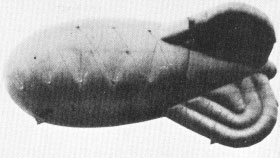 Click for Site Directory
Click for Site DirectoryBarrage Balloon Cables Collisions with Aircraft through 1939 to 1945
|
AIRCRAFT |
UNARMED BALLOON CABLE |
ARMED BALLOON CABLE |
|
|
Crashed Forced Proceeded Uncertain Landed |
Crashed Forced Proceeded Uncertain Total Landed |
|
Friendly |
23
18
57
1 |
68
20
115
8
310
|
|
Hostile |
12
8
5 |
13 1 13 2 54 |
|
Unknown |
2 |
1 6 1 10 |
|
TOTAL |
35
18
67
6 |
82
21
134
11
374 |
is that barrage balloons of the armed or unarmed cable design seemed to have been hit by more “Friendly” aircraft than “hostile”, the armed
cable design shown to be more effective than the unarmed cable design. One must bear in mind that while at first glance this might suggest
barrage balloons did more harm than good to the war effort in WWII, the number of friendly aircraft in the air over Britain per day was much
higher than the number of hostile aircraft over Britain per day.
So this shows that barrage balloons were effective at damaging or bringing aircraft down. During the war 310 friendly aircraft hit balloon
cables and 54 hostile ones hit cables with around 10 cable hits unable to be logged as friendly or hostile.
The balloons caused 91 friendly crashes with 38 friendly aircraft being forced to land. Despite hitting a cable, 172 friendly aircraft were not
damaged badly and were able to carry on flying. Around one third (91/310) of all friendly aircraft who hit a cable crashed.
The balloons caused 25 hostile crashes with 1 hostile aircraft being forced to land. Despite hitting a cable 21 hostile aircraft were not
damaged badly and were able to carry on flying. Around one half (25/54) of all hostile aircraft who hit a cable crashed. What this does not
show is the effectiveness of barrage balloons as a potential threat to enemy aircraft. Only once have I been able to talk to a former member
of the Luftwaffe and he told me that it was their greatest fear as they got nearer to the target.
It was so unknown, equally if a pilot saw a balloon barrage he could assume that around and below it lay something worth bombing. As a result
some aircraft would drop their bombs in such areas particularly if they knew they were never going to reach their primary target. If pursued by
British fighters, many German aircraft dropped their bombs, this lightened their load and gave them increased speed and fuel to try to outrun the
fighters. I am indebted to Den Burchmore and the Airship Heritage Trust for help with the above information.
The Balloon Command motto: VI ET ICTU “By force and impact”, says it all.
DEATAILS OF COLLISIONS – ENEMY AIRCRAFT AND
BALLOON CABLES
DATE
BARRAGE
TYPE OF AIRCRAFT
RESULT
DATE
BARRAGE
TYPE OF AIRCRAFT
RESULT
DO 217
DO 217E
Proceeded.
Period
No. of
Impacts
No. of Crashes
June 7 4
July 11 3
August 7 1
September 4 1
October 14 7
November 5 1
December 5 1
February 4 2
March 4 1
April 3 1
May 2 1
June 2 -
July 3 1
August 9 2
September 5 -
October 6 3
November 6 3
December 1 -
February 3 2
March 7 3
April 2 1
May - -
June 6 -
July - -
August 3 1
September 1 1
October 2 1
November - -
December 3 -
February 4 -
March 4 1
April 9 1
May 10 2
June
3
1
278 93
May 1941 – June 1944 – C.S.4449, Parts I –